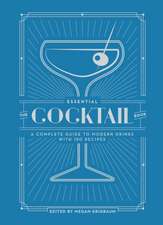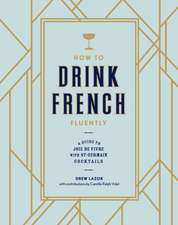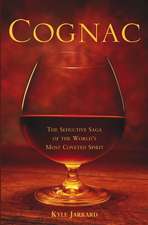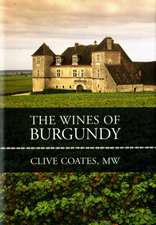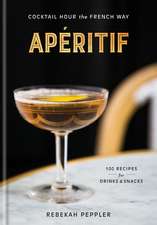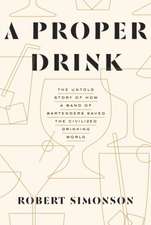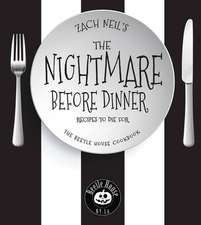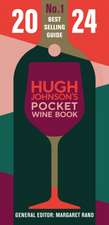Bitters
Autor Brad Thomas Parsonsen Limba Engleză Hardback – 3 noi 2011
Vezi toate premiile Carte premiată
Gone are the days when a lonely bottle of Angostura bitters held court behind the bar. A cocktail renaissance has swept across the country, inspiring in bartenders and their thirsty patrons a new fascination with the ingredients, techniques, and traditions that make the American cocktail so special. And few ingredients have as rich a history or serve as fundamental a role in our beverage heritage as bitters.
Author and bitters enthusiast Brad Thomas Parsons traces the history of the world’s most storied elixir, from its earliest “snake oil” days to its near evaporation after Prohibition to its ascension as a beloved (and at times obsessed-over) ingredient on the contemporary bar scene. Parsons writes from the front lines of the bitters boom, where he has access to the best and boldest new brands and flavors, the most innovative artisanal producers, and insider knowledge of the bitters-making process.
Whether you’re a professional looking to take your game to the next level or just a DIY-type interested in homemade potables, Bitters has a dozen recipes for customized blends--ranging from Apple to Coffee-Pecan to Root Beer bitters--as well as tips on sourcing ingredients and step-by-step instructions fit for amateur and seasoned food crafters alike.
Also featured are more than seventy cocktail recipes that showcase bitters’ diversity and versatility: classics like the Manhattan (if you ever get one without bitters, send it back), old-guard favorites like the Martinez, contemporary drinks from Parsons’s own repertoire like the Shady Lane, plus one-of-a-kind libations from the country’s most pioneering bartenders. Last but not least, there is a full chapter on cooking with bitters, with a dozen recipes for sweet and savory bitters-infused dishes.
Part recipe book, part project guide, part barman’s manifesto, Bitters is a celebration of good cocktails made well, and of the once-forgotten but blessedly rediscovered virtues of bitters.
Preț: 119.30 lei
Preț vechi: 137.67 lei
-13% Nou
22.83€ • 23.83$ • 18.89£
Carte disponibilă
Livrare economică 15-22 martie
Livrare express 01-07 martie pentru 62.73 lei
Specificații
ISBN-10: 1580083595
Pagini: 231
Ilustrații: 50 Full-Colour Photos
Dimensiuni: 174 x 232 x 30 mm
Greutate: 0.84 kg
Editura: Ten Speed Press
Notă biografică
Extras
Cocktail culture has come a long way since I last worked behind the bar, which was in the early 1990s at Harpoon Eddie’s in Sylvan Beach, New York, a town optimistically billed as “the Coney Island of Central New York.” During college summer vacations I spent most of my shifts whipping up rum runners and strawberry daiquiris (by pressing a button on a constantly whirring machine that was eerily similar to the Slurpee station at a 7-Eleven), pulling endless pitchers of beer, and mixing innumerable Cape Codders. Our sour mix came out of a sticky soda gun, there was no such thing as simple syrup, and citrus juices were delivered to us in oversized cans from Sysco. I do remember a rarely reached-for bottle of Angostura bitters, with its distinctive yellow cap and oversized label, which was tucked away behind the house copy of Mr. Boston: Official Bartender’s Guide. The only time I reached for the bitters was when Maurie, one of our regulars, ordered the occasional Manhattan, which I served in one of the four cocktail glasses we kept hanging on the rack (most of the beach-bound drinks were served in plastic cups). Granted, slinging drinks during your college years at a popular beach bar has its allure: 25-cent hot wing Wednesdays, beach volleyball tournaments, a prime seat for Fourth of July fireworks, plenty of bikinis, and decent tips. I try to make it back to Harpoon Eddie’s at least once a summer when I’m back home, and I have a sneaking suspicion that the same bottle of bitters might still be behind the bar.
Most college students will drink whatever they can get their hands on--often to disastrous results (think grain alcohol holiday punch served from a Hefty bagߝlined trash bin, spiked with peppermint schnapps and stained red from the box of candy canes the host dumped in as a garnish). In those days, my experience with what is now considered “speakeasy chic” was limited to the evenings when I would swing by the bar at the local members-only American Legion to ask my dad a favor (usually to borrow the car or twenty dollars; sometimes both). There the bartender would peer through the mirrored glass window to see who was at the door and buzz you in.
After several semesters of these ill-advised punches, fake IDs, and an excess of drinks that will never touch my lips again (I’m talking to you, Kahlúa and cream--and to any other cream-based drink that was pressed into my hands), it took me a long time to come to appreciate and understand the balance required of a proper cocktail. After college I cut my teeth on vodka martinis and vodka gimlets, but eventually I embraced brown spirits, especially bourbon and rye, and then, as a fully formed adult, I moved onto the pleasures of aperitifs and digestifs flavored with bitters, herbs, and botanicals.
* * * *
Aromatic cocktail bitters--the kind you don’t sip but add in dashes to enliven a drink--were an essential ingredient in classic cocktails, and are now back and bigger than ever. Just as restaurant menus herald the local farmer who grew the heirloom carrots featured in that night’s special, cocktail menus increasingly single out house-made bitters and those made by artisanal producers. And indeed, seeking out the best bitters can become as much of an obsession as finding the freshest locally sourced ingredients. The same DIY ethos that made growing tomatoes on your apartment’s rooftop, making your own seasonal preserves, curing charcuterie on your fire escape, and all sorts of other hands-on kitchen projects so popular over the past five or so years has rolled out to bars. Today listing house-made bitters on the menu and displaying dozens of homemade tinctures is a benchmark for most serious bar programs. Once I’ve sized up a joint, I’ll ask the bartender, “Do you make your own bitters?” More often than not the answer is yes: orange, grapefruit, coffee, barley, cherry-vanilla, plum, rhubarb, rosemary, and lavender, to name just a few.
Asking that simple question makes me feel connected to an ongoing conversation about the history of the American cocktail. And it’s not just because the bartender is decked out in his nineteenth-century best and most likely sporting a Civil Warߝera beard or artfully waxed mustache. It’s because that simple old-fashioned--the one made with rye, simple syrup, bitters, and a lemon twist--is practically what you would be holding in your hand if you walked into a bar in the late 1800s and Jerry Thomas served you himself.
* * * *
In 2009 I wrote a short piece on homemade bitters for Seattle Met magazine. I quickly geeked out on the topic, and sharing my enthusiasm with so many bartenders who were also on the bitters trail only increased my obsession. At the bar Spur in Seattle, where David Nelson was bartending when I wrote the piece (bartenders, like ballplayers, move around to other teams all the time), there were nearly two dozen squat glass bottles lining the bar, each filled with one of Nelson’s homemade bitters and tinctures. When David said, “You know, it would be pretty ingenious if someone wrote a book on bitters,” his words stuck with me, and I shared David’s sentiment with my friend A. J. Rathbun, who writes a new cocktail book nearly every year. He smiled and said, “Don’t look at me. That’s all you, my friend.” That night I revisited my dog-eared copy of Imbibe!, David Wondrich’s award-winning historical biography of Jerry Thomas, America’s first celebrity bartender and the man who in 1862 published the first known collection of cocktail recipes. I came across this quote in Wondrich’s book: “As for the bitters and syrups, were these to receive the attention they deserve, they would easily fill another volume the size of this one.” That sealed the deal for me. I was a man on a mission. It was fortunate that I got into the bitters game just as they were reclaiming their proper place behind the bar.
When I’m into something--a band, a book, a bourbon--I tend to get a bit obsessed. Growing up (and even well into adulthood), I collected Star Wars action figures. And that same completist spirit--needing to have every variation of every character--came back to me as I tracked down as many bitters as I could, both in stores and online. As soon as a new brand or flavor came on the market, I would scoop it up and take it home to experiment. I researched and tracked down old bitters recipes online and in vintage cocktail books to make my own bitters at home, and I scored samples of new releases and homemade bitters from bartending friends. Today I consider my bitters collection pretty impressive, but there’s still more out there, and more coming on the market every month. And there are still those holy grail bitters to track down, bitters that keep my quest alive: securing an unopened bottle of Suntory Hermes Orange Bitters from Japan is almost as impossible as finding the elusive 1979 mail-order rocket-firing Boba Fett.
* * * *
One evening at the Seattle bar Vessel, as bartenders Jim Romdall and Keith Waldbauer were passing me sample-size bottles of new bitters to try, Keith said to me, “You know, by the time your bitters book comes out, it’s already going to be out of date.” A lesser man might have been discouraged by Keith’s remark, or the idea that a book won’t be able to keep up with all the new bitters entering the marketplace, but I actually think his words point to something exciting. As recently as 2003, there were only a handful of bitters available commercially, and it had been that way for more than 150 years, but now there are dozens of new flavors just a mouse click away. To stay abreast of new bitters trends, visit my website www.btparsons.com, where I’ll keep you up to date on any new bitters that enter the marketplace.
After reading news about this book, a cocktail writer posted on Twitter, “A whole book on bitters? I’m incredulous and delighted.” If this book inspires you to dig out that bottle of Angostura from the back of your cupboard or seek out an orange or celery or grapefruit bitters to play around with at home, then I’ve done my job, and I will be equally delighted.
Old-Fashioned
Because it is predated by the bittered sling, the old-fashioned may not be the “oldest” cocktail; however, it hews closest to the original definition of the word (spirits, bitters, sugar, and water). Its origin is typically traced back to the 1880s at the Pendennis Club of Louisville, Kentucky. From there it traveled to New York City, when club member Colonel James E. Pepper took it on the road and introduced it to the bar at the Waldorf-Astoria Hotel. The original recipe is a thing of austere beauty: a lump of sugar dissolved with a little water and two dashes of bitters, whiskey, a bit of ice, and a lemon peel garnish.
Since then, many modern old-fashioned recipes have adopted the “fruit salad” approach, calling for an aggressively muddled pulp of sugary orange wheel and maraschino cherry, but the original is making a comeback. For me, tasting a supersweet old-fashioned with a bit of sugary grit on the tongue does invoke a memory of old-fashioneds past (mostly stolen sips from my father’s glass), but the historically accurate drink needs no more than the adornment of a lemon peel. Using simple syrup instead of a sugar cube takes the showy act of muddling out of the equation, but the syrup easily dissolves into the drink without leaving any residue.
The simplicity of the old-fashioned means that it lends itself to multiple variations. Just mix and match your bourbon or rye with different bitters, and the sugar can take the form of a flavored syrup or even maple syrup. I’m fond of putting an autumnal twist on the old-fashioned by using bourbon, cinnamon syrup, and apple bitters.
Combine the rye or bourbon, simple syrup, and bitters in a mixing glass filled with ice. Stir until chilled and strain into a chilled double old-fashioned glass filled with large pieces of cracked ice or a large ice cube. Garnish with the lemon or orange zest.
Makes 1 drink
2 ounces rye or bourbon
1/4 ounce simple syrup (page 92)
3 dashes Angostura or other aromatic bitters
Garnish: thick piece of lemon or orange zest
Manhattan
Better cocktail historians than I have presented and debunked endless accounts of how the Manhattan came to be, so I won’t waste ink here rehashing those colorful stories (see Gary Regan, William Grimes, and David Wondrich for that). While bourbon has become the de facto spirit in most Manhattans, the classic spirit for this drink is rye (though I would never turn down a bourbon Manhattan). Always stir this drink, never shake it. And a Manhattan isn’t a Manhattan without the bitters. Angostura is the way to go for a classic, but I personally like to split the difference and use one dash of aromatic bitters and one dash of orange. Going all orange tends to ramp up the sweetness without bringing the spice.
Combine the rye or bourbon, vermouth, and bitters in a mixing glass filled with ice. Stir until chilled and strain into a chilled coupe or cocktail glass. Garnish with the cherry or lemon twist.
Makes 1 drink
2 ounces rye or bourbon
1 ounce sweet vermouth
1 dash Angostura or other aromatic bitters
1 dash orange bitters
Garnish: amarena or marasca cherry or lemon twist
Recenzii
Winner, IACP Awards 2012- Wine, Beer or Spirits Category
“Finally, here is an entire book devoted to the history, culture, and uses of the herbal elixir.”
—BonAppetit.com “Best Cookbooks of 2011”
“Gorgeous and fascinating… highly recommend for those interested in spirits.”
—Michael Ruhlman, 12/2/11
“Engaging…gorgeous….The book practically begs for a dark leather chair, a roaring fireplace, and a Manhattan…a nearly ideal gift.”
—Serious Drinks, 12/1/11
“Stylish, engaging, geek-attack-inducing…The beautiful art in Bitters invites readers to touch, open and browse, and the prose is as intelligent as the photography is beautiful. Whether it's found on the coffee table, in the kitchen or behind the bar, this book incites readers to explore, create and share.”
—Shelf Awareness, 11/22/11
“This is graduate-level stuff and would be a welcome addition to any cocktail geek's library.”
—Wall Street Journal, 11/19/11
“Brad Thomas Parsons tracks the bitters boom in his new book Bitters, and manages to elevate herbs to an art form.”
—Newsweek, 11/14/11
“Fascinating…Parsons offer[s] techniques for making bitters at home as well as a great collection of unique cocktail recipes.”
—The Washington Post, 11/8/11
“The literary apotheosis of the bizarre and undeniably beautiful artisanal and historic cocktail trend.”
—The Atlantic, 11/4/11
“Cocktails are very much in again and bitters are the belle of the ball. We are totally ready to geek out with this one.”
—The Huffington Post, 8/25/11
“Brad has not only written the definitive volume on bitters, but also proven himself a bartender of the highest order: an inspired mixologist and a gifted storyteller whose generous, engaging voice makes you want to order round after round.”
—Matt Lee and Ted Lee, authors of The Lee Bros. Simple Fresh Southern
“Bitters turns a potentially esoteric topic into a breezy read, packed with recipes for the bar and kitchen that we will certainly be adding to our repertoire. Brad’s witty, generous storytelling and excellent historical research, paired with the handsome visuals, set this book apart.”
—Frank Castronovo and Frank Falcinelli, authors of The Frankies Spuntino Kitchen Companion & Cooking Manual and chef/owners of Frankies Spuntino and Prime Meats
“I love bitters! Brad’s book is a must-have for all booze nerds. The history is fascinating and the recipes are awesome.”
—David Chang, chef/owner of Momofuku
“Thanks to Brad Thomas Parsons’s inquisitive detective work, readers can discover how cocktail bitters rose from the ashes of Prohibition to become an indispensable ingredient for the country’s top mixologists.”
—Jim Meehan, managing partner at PDT and author of The PDT Cocktail Book
“Similar to the mysterious and storied elixir it documents, Bitters is bright, refreshing, complex, and essential. It will also cure your gout. Any fan of cocktails will desire it, but so will any fan of fascinating history, good writing, or gentian root.”
—John Hodgman, author of That Is All
Cuprins
Introduction . . . . . 1
A Brief History of Bitters . . . . . 7
A Bitters Boom . . . . . 23
Making Your Own Bitters . . . . . 41
Apple Bitters . . . . . 52
BTP House Bitters . . . . . 54
Charred Cedar Bitters . . . . . 56
Cherry-Hazelnut Bitters . . . . . 58
Coffee-Pecan Bitters . . . . . 60
Grapefruit Bitters . . . . . 62
Husk Cherry Bitters . . . . . 64
Key Lime Bitters . . . . . 66
Maggie’s Rhubarb Bitters . . . . . 68
Meyer Lemon Bitters . . . . . 70
Orange Bitters . . . . . 72
Pear Bitters . . . . . 74
Root Beer Bitters . . . . . 76
Setting Up Your Bar . . . . . 79
Bitters Hall of Fame . . . . . 105
Old-Fashioned . . . . . 107
Manhattan . . . . . 108
Champagne Cocktail . . . . . 111
Sazerac . . . . . 112
Old-Guard Cocktails . . . . . 115
Abbey Cocktail . . . . . 116
Alaska Cocktail . . . . . 117
Allegheny Cocktail . . . . . 118
Angostura Fizz . . . . . 118
Bijou Cocktail . . . . . 120
Brandy Crusta . . . . . 121
Corn ’n’ Oil . . . . . 123
Cuba Libre . . . . . 124
Dark and Stormy . . . . . 125
East India Cocktail . . . . . 126
Fourth Regiment Cocktail . . . . . 127
Harvard Cocktail . . . . . 127
Horse’s Neck . . . . . 129
Japanese Cocktail . . . . . 130
Jersey Cocktail . . . . . 130
Martini . . . . . 132
Martinez Cocktail . . . . . 134
Mint Julep . . . . . 135
Negroni . . . . . 137
Old Hickory . . . . . 138
Pegu Club Cocktail . . . . . 138
Pink Gin . . . . . 140
Pisco Sour . . . . . 143
Remember the Maine . . . . . 144
Rob Roy . . . . . 144
Satan’s Whiskers . . . . . 145
Scofflaw Cocktail . . . . . 145
Seelbach Cocktail . . . . . 146
Toronto . . . . . 148
Vieux Carré . . . . . 148
New-Look Cocktails . . . . . 151
The 5th Avenue Cocktail . . . . . 153
Añejo Highball . . . . . 153
Autumn Sweater . . . . . 155
The Bitter Handshake . . . . . 156
Black Feather . . . . . 158
Black Scottish Cyclops . . . . . 159
Coxsackie Smash . . . . . 160
Cranberry Crush . . . . . 162
Cricket Ball . . . . . 163
Do You Believe in Miracles? . . . . . 164
Exile in Ryeville . . . . . 167
Fernet and Coke . . . . . 168
Gargoyle & Spire . . . . . 169
The Long Hello . . . . . 170
Michelada . . . . . 172
Mrs. Kitzel . . . . . 174
Pith Helmet . . . . . 175
Primo Avenue Punch . . . . . 177
Red Carpet Reviver . . . . . 178
Sawyer . . . . . 181
Scuppernong Sour . . . . . 182
Shady Lane . . . . . 185
Sorghum Flip . . . . . 186
Tipsy Nissley . . . . . 187
Tombstone . . . . . 190
Trident . . . . . 190
Turkey Shoot . . . . . 191
White Light/White Heat . . . . . 193
Woodland Sunset . . . . . 194
Zim Zala Bim . . . . . 195
Bitters in the Kitchen . . . . . 197
Broiled Bitter Grapefruit . . . . . 201
Sweet & Spicy Bitter Bar Nuts . . . . . 202
Compound Bitters Butters . . . . . 204
Bitters Vinaigrette . . . . . 206
Bourbon-Bitters Holiday Ham Glaze . . . . . 207
Chinese-Style Takeout Ribs with Lacquered Bitters Glaze . . . . . 208
Hot & Sticky Bitter Wings . . . . . 210
Bitters-and-Balsamic Macerated Strawberries . . . . . 211
Bitter Apple Fried Hand Pies . . . . . 212
Bitters-Sweet Chocolate Malted Pudding . . . . . 214
Boozy Bitter Granitas . . . . . 216
Aromatic Bitters Ice Cream . . . . . 218
Resources . . . . . 220
Recommended Reading for the Cocktail Enthusiast . . . . . 222
Acknowledgments . . . . . 224
Index . . . . . 227
Descriere
A cocktail renaissance has swept across the country, inspiring in bartenders and their thirsty patrons a new fascination with the ingredients, techniques, and traditions that make the American cocktail so special. And few ingredients have as rich a history or serve as fundamental a role in beverage heritage as bitters.
Premii
- IACP Crystal Whisk Award Winner, 2012
- James Beard Foundation Book Awards Winner, 2012


